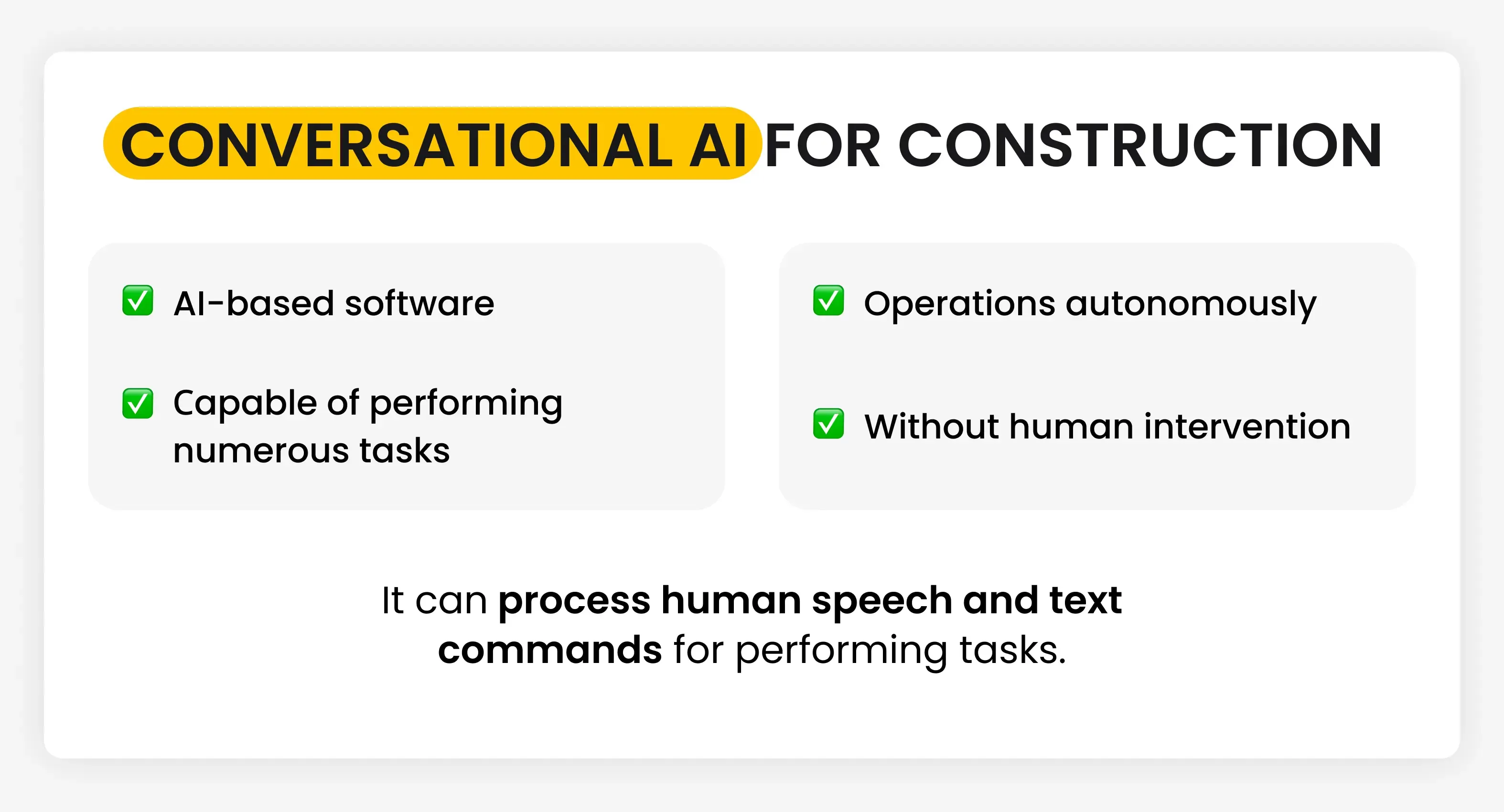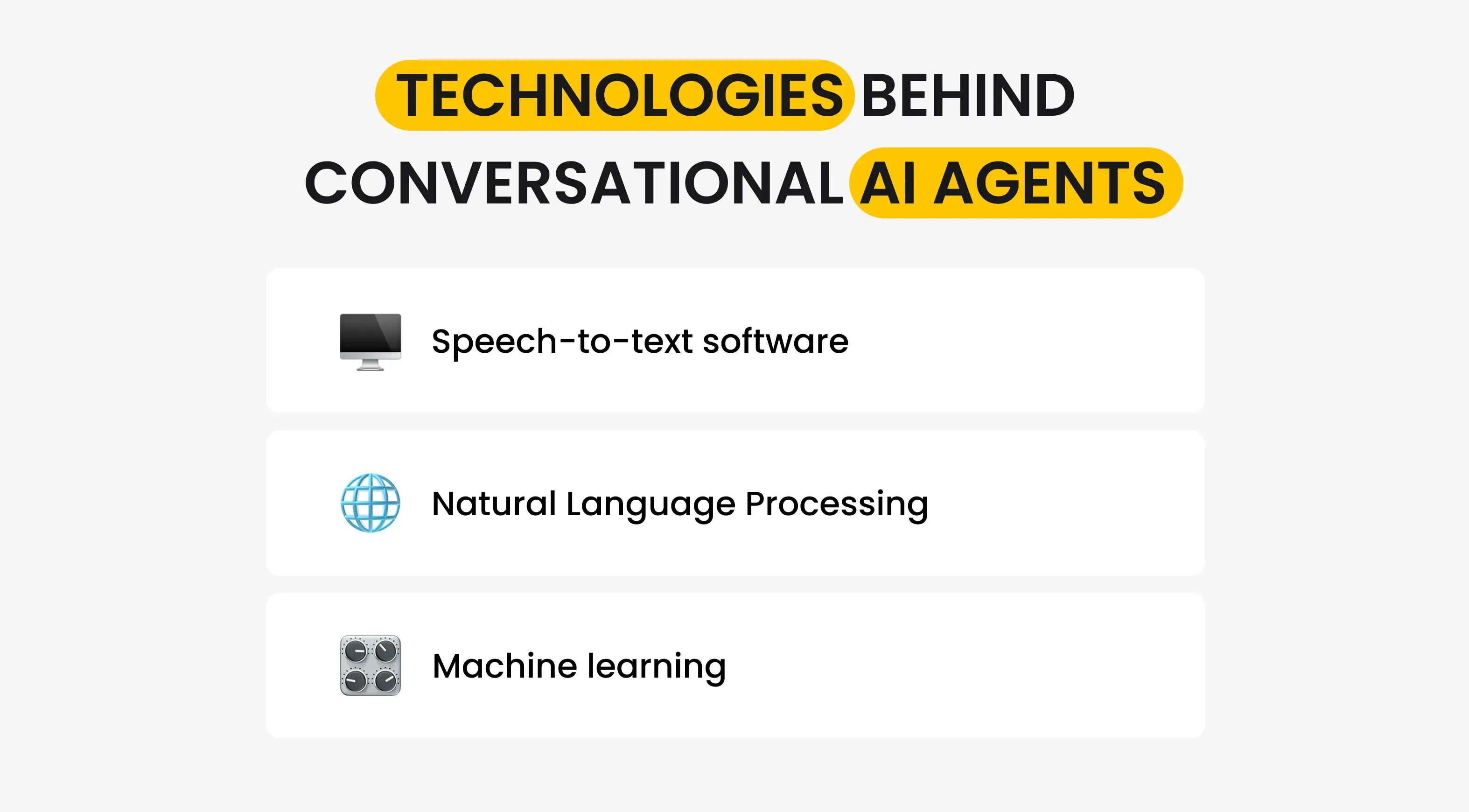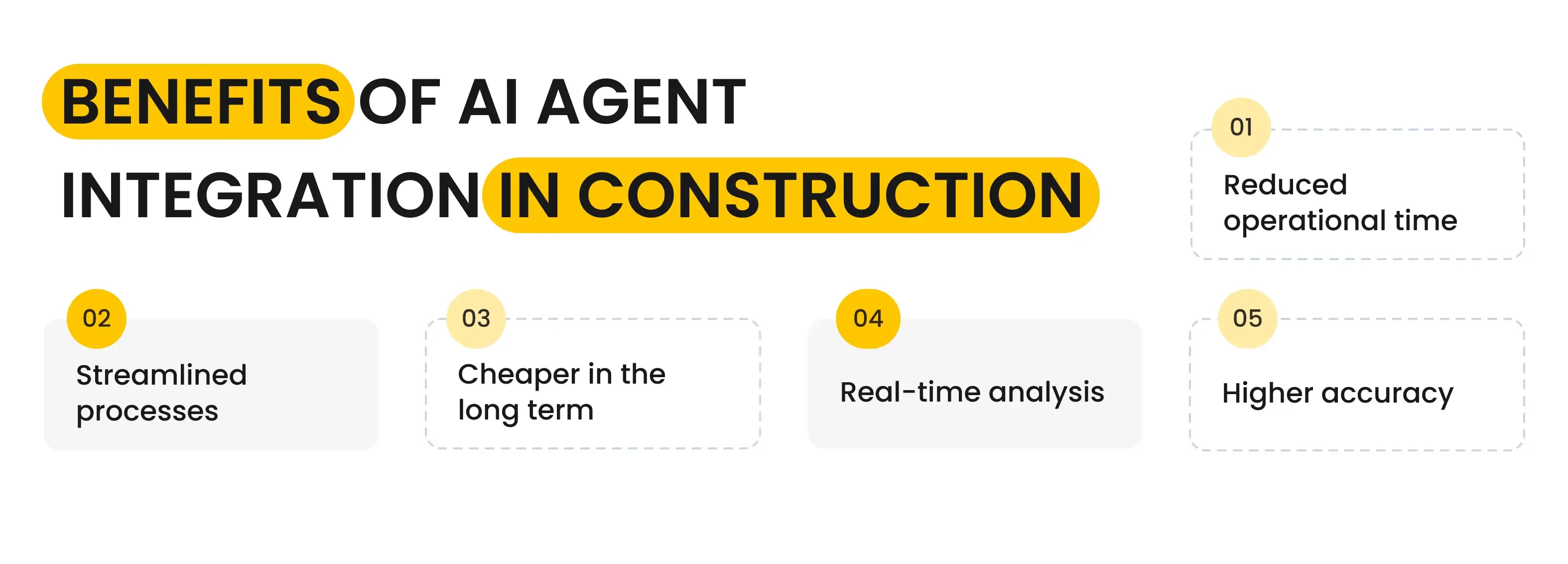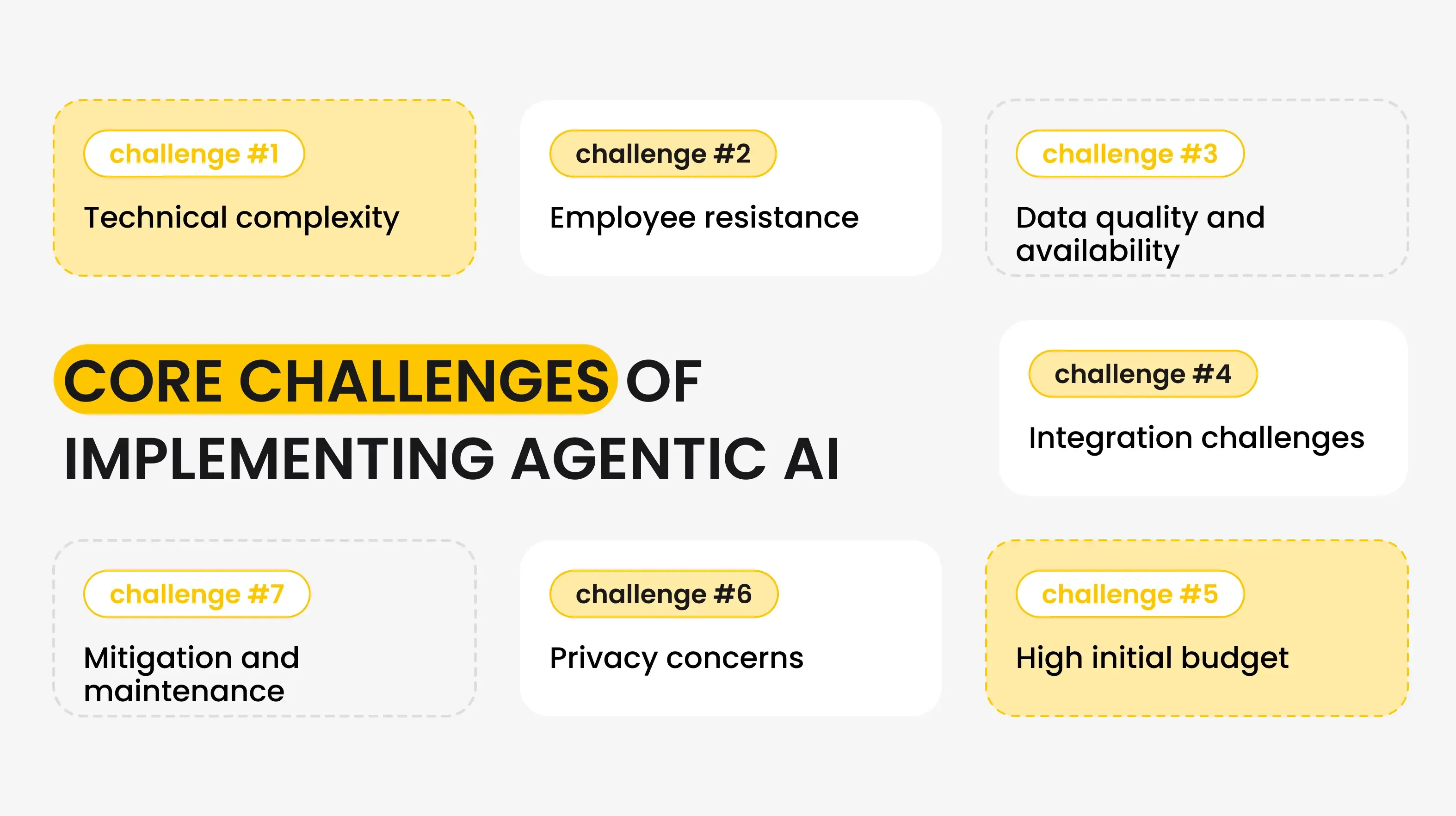Construction
From 10 to 2 Hours: How Conversational AI Agents Transform Construction Report Generation
October 24, 2025 • 102 Views • 28 min read
Bohdan Vasylkiv
CEO & Co-Founder
Latest cases demonstrate that conversational AI agents are revolutionizing the generation of construction reports. Thanks to these innovative solutions, companies can reduce time-intensive documentation processes from 10 hours to just 2 hours per week.
This dramatic efficiency gain addresses one of the industry's most persistent productivity challenges, enabling project managers to focus on strategic decision-making rather than administrative tasks.
According to our experience, the transformation represents an 80% reduction in reporting time while simultaneously improving accuracy and compliance tracking.
The Growing Role of Conversational AI in Construction
Conversational AI construction solutions are emerging as core drivers of digital efficiency, fundamentally transforming traditional workflows and data collection processes.
The global conversational AI market scales at an enormous rate. According to the latest GMI report, the market size of artificial intelligence in construction was estimated at $2.5 billion in 2022. Today, analysts expect it to grow to over $15 billion by 2032. This rapid adoption reflects the industry's urgent need to address labor shortages, improve productivity, and enhance project visibility.
We all know that the construction industry has historically lagged behind other sectors in digitization. Still, conversational AI construction platforms are bridging this gap by providing intuitive interfaces that require minimal technical expertise. These systems utilize natural language processing (NLP) to comprehend context, analyze field reports, and automatically generate comprehensive documentation.
Unlike traditional software that requires extensive training, conversational AI agents operate through familiar chat interfaces, making adoption seamless for field teams. Furthermore, these solutions provide entirely new ways to interact with management systems.
Nowadays, construction progress monitoring has become increasingly sophisticated through the integration of AI. Such systems are capable of processing visual data from drones, sensors, and mobile devices to create real-time project insights. Not to mention their ability to recognize and process human speech, thanks to built-in voice technology in construction.
This technological convergence enables construction firms to maintain continuous visibility into project status while reducing the administrative burden that traditionally consumed 20% of project management time.
What Is a Conversational AI Agent and How It Works in the Construction Industry

A conversational AI-driven agent is an advanced software system that combines natural language processing, machine learning algorithms, and industry-specific knowledge to simulate human conversation and automate complex tasks.
In construction applications, these technologies serve as intelligent intermediaries between field teams and project management systems. They are capable of understanding spoken instructions, processing visual data, and generating structured reports without human intervention.
AI chatbot implementations in the construction industry typically integrate multiple data inputs, including sensor readings, photographic evidence, weather conditions, equipment status, and workforce attendance. The system's NLP models process this information through sophisticated algorithms that can identify patterns, detect anomalies, and extract relevant project insights.
Modern conversational AI agents employ transformer-based architectures, similar to those powering advanced language models, enabling them to comprehend context and maintain coherent dialogue across extended interactions.
These platforms seamlessly integrate with established software, such as Procore, Autodesk Build, and Microsoft Project, automatically updating schedules, flagging delays, and notifying relevant stakeholders. The integration process typically involves AI API connections that enable real-time data synchronization. It helps to ensure that conversational AI insights inform project decision-making processes immediately.

The technical architecture encompasses several key components:
- Speech recognition modules that convert voice inputs to text,
- NLP engines that interpret intent and extract entities,
- Knowledge bases containing construction-specific terminology and processes,
- Response generation systems that produce contextually appropriate outputs.
This comprehensive framework enables construction teams to interact naturally with project data while maintaining the precision required for professional documentation.
Time Reduction in Construction Report Generation: Manual vs AI-Automated Processes
At the moment, there are three main approaches to construction reporting:
- Traditional manual reporting, when employees write down and share reports with other employees or departments
- Semi-automated reports, based on software solutions with built-in templates for faster and simpler report creation
- AI-powered reporting agents with elevated autonomy, data processing automation features, and possible decision-making options.
Why Construction Reporting Is Time-Consuming and Error-Prone
Traditional construction reporting relies heavily on manual processes that create significant inefficiencies throughout project lifecycles.
Daily progress reports, safety documentation, and compliance tracking typically require managers to spend 2-3 hours per day collecting data, formatting documents, and distributing updates to stakeholders. This manual approach creates multiple points of failure where critical information can be lost, misinterpreted, or delayed.
The fragmented nature of construction communication compounds these challenges for your success:
- Project information often spans multiple platforms, including email chains, messaging apps, spreadsheets, and various software systems.
- Field teams usually record observations in unstructured formats, which requires project managers to interpret and organize this information into standardized reports manually. It consumes valuable time, introduces human error, and results in information loss.
- Data accuracy is the final significant challenge in manual reporting systems, based on the previous two factors.
It is not a secret that construction projects generate vast amounts of information daily, including labor hours, material deliveries, equipment usage, weather conditions, and progress milestones.
When project managers manually consolidate this data daily, fatigue and information overload often result in inconsistencies and omissions. These errors can cascade into larger project issues, affecting schedule accuracy, budget management, and regulatory compliance.
The timing delay inherent in manual reporting worsens these problems further. By the time daily reports are compiled and distributed, critical issues may have already impacted project progress. This reactive approach prevents proactive problem-solving and limits the ability to implement timely interventions that could prevent delays or cost overruns.
Predesigned SaaS solutions for construction management can help to mitigate some risks. At least, they can provide employees with tools for centralized and standardized data updates and reporting. Still, these solutions are costly and rigid, commonly facing adoption resistance among employees, who are accustomed to traditional methods of managing data and time updates.
The Impact of Conversational AI Systems on Construction Reporting
Everyone knows that filing construction forms and reports is a very routine and highly manual job that requires workers to write similar texts for hours. This not only takes a lot of time but also frustrates your employees due to the task's repetitiveness. Moreover, apart from filing the reports, the rest of the team must read and analyze them to gather valuable information.
Thanks to AI integration, you can streamline both processes. First, your workers can use the generative AI to write template-based reports in minutes instead of hours. Second, the same AI can provide analytics and summaries, which are essential for long or complex texts.
As a result, you not only reduce stress and speed up everyday processes, but also benefit from freeing your employees to take on more urgent, complex, or interesting tasks.
Basically, conversational AI construction tools fundamentally transform the reporting process by automating data entry, standardizing report generation, and enabling real-time information processing.
Judging from our experience, AI-powered reporting systems reduce documentation time from an average of 10 hours per week to approximately 2 hours, representing an 80% efficiency improvement. This dramatic reduction results from the elimination of manual data consolidation and the automation of repetitive formatting tasks.
The acceleration occurs through several key mechanisms:
-
First, conversational AI agents continuously collect data throughout the workday rather than requiring end-of-day compilation. IoT sensors, mobile devices, and automated systems feed information directly into the AI platform, which processes and categorizes this data in real-time.
-
Second, natural language processing enables field teams to provide updates through voice commands or casual text inputs, eliminating the need for structured data entry.
-
The accuracy improvements prove equally significant. AI systems maintain consistent data validation rules and are immune to fatigue-related errors. They detect anomalies in real-time, flag missing information, and ensure compliance with reporting standards. This reliability enables project managers to trust automated reports and focus their attention on strategic decision-making rather than data verification.
-
Real-time analysis capabilities provide additional value beyond time savings. AI systems can identify trends, predict potential delays, and recommend proactive interventions based on current project data. This predictive capacity transforms your reporting from a backward-looking documentation exercise into a forward-looking management tool that supports continuous project optimization and improvement.
5 Key Reasons to Adopt a Conversational AI Agent in Construction
There are many benefits to adopting AI for various purposes. For instance, AI-driven chatbots are already conquering customer support services, offering numerous features and advantages for businesses.

If we are talking about the construction industry, it is possible to name five key reasons for such integration:
- Real-time data management
- Enhanced accuracy
- Integration with other tools
- Better communication/collaboration
- Faster data-driven decision-making
1. Real-Time Data Capture and Reduced Administrative Load
Conversational AI agent systems eliminate the administrative bottleneck that traditionally consumes 20% of project management time.
These platforms automatically capture data from multiple sources. They process this information continuously throughout the workday rather than requiring compilation at the end of the shift.
Field teams can report progress, incidents, and observations using natural language inputs, which the AI system immediately converts into structured data compatible with project management databases.
Once again, the administrative load reduction extends beyond simple time savings. AI agents handle routine tasks such as weather logging, attendance tracking, equipment status monitoring, and safety checklist verification, all without requiring human intervention.
This automation frees superintendents and project managers to focus on strategic activities, including problem-solving, stakeholder communication, and quality control oversight.
Construction companies report that this shift enables their management teams to spend 60% more time on high-value activities that directly impact project outcomes.
2. Enhanced Accuracy and Compliance in Reports
AI-powered reporting systems deliver superior accuracy compared to manual processes by eliminating human error factors such as fatigue, distraction, and information overload.
These conversational AI construction agents implement consistent data validation rules, automatically cross-reference information against project schedules and specifications, as well as flag inconsistencies in real-time. The result is documentation that meets regulatory requirements with 95% accuracy, compared to the 75-80% accuracy typical of manual reporting systems.
Compliance tracking becomes significantly more robust through automated monitoring of safety protocols, quality standards, and regulatory requirements. AI conversational agent platforms can process construction documents against building codes, safety regulations, and contractual obligations, identifying potential violations before they become legal risks.
This proactive compliance management reduces the likelihood of costly corrections, regulatory penalties, and project delays associated with non-compliance issues.
3. Seamless Integration with Project Management Tools
Modern conversational AI systems integrate directly with established project management platforms, including Procore, Autodesk Build, PlanGrid, and Microsoft Project, through robust API connections.
This integration enables the real-time synchronization of project data, automatic schedule updates, and immediate stakeholder notifications, all without requiring manual data transfer between systems. Project teams can maintain their existing workflows while gaining enhanced automation capabilities.
The AI chatbot for construction industry integration extends to financial management systems, enabling automatic cost tracking, budget monitoring, and progress billing calculations based on real-time project data.
AI agents can process labor hours, material usage, and equipment costs to generate accurate project financial reports that support data-driven decision-making. Such a comprehensive integration creates a unified project management ecosystem that eliminates information silos and improves cross-functional collaboration.
4. Improved Team Communication and Collaboration
An AI chatbot for construction industry applications enhances communication by providing 24/7 availability for project inquiries, status updates, and information retrieval.
Team members can query project status, access historical data, and receive updates through natural language interactions regardless of time zones or work schedules. This continuous availability is particularly beneficial for projects with distributed teams or multiple shifts.
The collaborative benefits extend to stakeholder communication through automated report distribution, customized updates for different audiences, and real-time project dashboards.
AI systems can generate executive summaries for owners, detailed technical reports for engineers, and operational updates for field teams from the same underlying data. This tailored communication approach ensures that each stakeholder receives relevant information in the most suitable format, eliminating the need for manual customization.
5. Faster Decision-Making Through Instant Insights
Conversational AI platforms provide instant access to project analytics through natural language queries, enabling managers to assess project status and identify emerging issues quickly.
Rather than waiting for scheduled reports or manually analyzing data, project leaders can ask questions like "What's causing delays in the electrical phase?" and receive immediate, data-driven responses. This real-time insight capability accelerates problem identification and resolution.
Predictive analytics capabilities further enhance decision-making by identifying potential issues before they impact project schedules or budgets. AI systems analyze historical patterns, current progress rates, and external factors to forecast completion dates, resource requirements, and risk factors.
Such predictive insights enable proactive management interventions that prevent problems rather than merely responding to them after they occur.
Challenges of Implementing an AI Conversational Agent in Construction

The implementation of conversational AI in construction faces several significant challenges that require careful planning and strategic mitigation. This includes:
- The technical complexity of designing, developing, integrating, and training a proper model.
- Employees may resist innovative integrations if they are too complicated to learn or counterintuitive.
- There are numerous requirements for data quality and availability to ensure the efficient and accurate operation of the system.
- Difficulties with integrating complex AI models with legacy or outdated construction management systems.
- High initial budget and indirect expenses for AI model fine-tuning and integration projects.
- Privacy and security concerns about data access and processing.
- Mitigation and maintenance issues that include countless processes and operations planning, setting, and approval.
Technical complexity is the primary barrier, as construction companies often lack the necessary IT infrastructure and expertise to integrate AI systems with their existing project management platforms. Many firms struggle with data standardization, API compatibility, and system interoperability issues that can delay deployment and increase implementation costs.
-
User training and adoption present substantial cultural challenges within traditional construction environments. Field teams accustomed to paper-based processes or basic digital tools may resist conversational AI systems, particularly if they perceive these technologies as a threat to their job security. Successful implementation requires comprehensive change management programs that demonstrate clear benefits while addressing workforce concerns through training and support initiatives.
-
Data quality and availability challenges significantly impact the effectiveness of AI systems. Construction projects generate vast amounts of unstructured data across multiple formats, platforms, and stakeholders. Poor data quality, incomplete records, and inconsistent formatting can significantly limit the performance of AI systems, necessitating substantial data cleanup and standardization efforts before implementation. Additionally, many construction companies lack the historical data volumes necessary to train effective machine learning models.
-
Integration complexities with existing construction management systems create technical hurdles that require specialized expertise. Legacy systems often lack modern API capabilities, necessitating custom development to enable AI integration. The construction industry's fragmented technology landscape, with different trades using various software platforms, compounds these integration challenges and increases implementation timelines.
-
Cost considerations present significant barriers, particularly for smaller construction firms. Beyond initial software licensing fees, companies must invest in hardware upgrades, training programs, data migration, and ongoing maintenance. The return on investment timeline may extend beyond typical project durations, making it challenging to justify AI investments based on individual project benefits.
-
Privacy and security concerns necessitate careful attention in construction environments, where sensitive project information, proprietary methods, and competitive data must be safeguarded. AI systems that process voice recordings, photographic data, and detailed project information raise questions about data storage, access controls, and potential information leakage to competitors or unauthorized parties.
-
Mitigation strategies include phased implementation approaches that begin with pilot projects, comprehensive training programs that emphasize AI augmentation rather than replacement, robust data governance frameworks, and partnerships with experienced AI vendors who understand the specific requirements of the construction industry.
Successful implementations typically require 6-12 months of planning and gradual rollout to ensure user adoption and system optimization.
Building a Better Construction Workflow with Incora
The transformation from 10-hour manual reporting processes to 2-hour automated workflows represents more than just efficiency gains. It suggests a fundamental shift toward data-driven construction management, enabling proactive decision-making and continuous project optimization.
Conversational AI construction systems have proven their value through measurable improvements in accuracy, compliance, and team productivity while freeing valuable human resources for strategic activities that require creativity and critical thinking.
As the construction industry continues its digital transformation journey, conversational AI agents will evolve from innovative tools into essential infrastructure that supports every aspect of project management, from initial planning through final delivery. The firms that recognize and act on this opportunity will build smarter, faster, and more connected workflows that define the future of construction excellence.
If you're wondering how to start your AI implementation project or how it can benefit your business, drop us a line, and we will gladly help you decide on your next steps.
What’s your impression after reading this?
Love it!
27
Valuable
13
Exciting
6
Unsatisfied
1
FAQ
Let us address your doubts and clarify key points from the article for better understanding.
What are conversational AI agents in construction?
Conversational AI agents are software systems that use natural language processing (NLP) and machine learning to automate construction tasks. They understand spoken instructions, process data from drones and sensors, and generate structured reports without human intervention.
How much time can conversational AI save in reporting?
Conversational AI reduces report generation from 10 hours to 2 hours per week - an 80% time savings. This allows management teams to spend 60% more time on strategic activities instead of documentation.
What are the main benefits of conversational AI?
Key benefits include:
- Real-time data management from IoT sensors and drones
- 95% accuracy vs. 75-80% manual accuracy
- Seamless integration with Procore, Autodesk Build, and Microsoft Project
- 24/7 availability for project inquiries
- Faster decision-making through instant analytics
How does conversational AI integrate with existing software?
AI agents integrate through robust API connections enabling real-time data synchronization with project management and financial systems. This eliminates manual data transfer and provides automatic updates.
How accurate are AI-powered reports?
AI-powered reports achieve 95% accuracy compared to 75-80% manual accuracy. This improvement eliminates human error from fatigue, distraction, and information overload while ensuring consistent data validation.
What is the ROI timeline?
While initial costs are substantial, the 80% reporting time reduction provides immediate gains. Full ROI typically requires 6-12 months for planning, rollout, and system optimization.
Can conversational AI provide predictive analytics?
Yes, AI systems analyze historical patterns and current progress to forecast completion dates, resource needs, and risk factors. Project managers can ask questions like "What's causing electrical delays?" and receive immediate data-driven responses.
you may also like
Construction
AI Compliance Agent for Construction: Automating HSE and Regulatory Compliance
Construction
AI Shift Scheduling for Construction: Is This the Future of HR and Payroll?
Management Systems
Construction Project Management Software for Small Business: Complete Guide
Construction
How AI Negotiation Agents Improve Construction Procurement [And Why Do You Need It]
Construction,
Real Estate
How Construction Workflow Management Software Helps to Reduce Costs and Boost Efficiency?
Construction
How Integrated BOQ Software Bridges the Gap Between Construction Departments
Construction
How to Create a Procore Alternative Software for a Construction Business
Construction
How to Deal With Weaknesses of Construction Financial Management Software?
Real Estate
How to Select the Right Construction Management Software for Your Business
Construction
Investing in the Right Construction Reporting Software: Features That Make a Difference
Construction
Is Voice Technology Worth the Investment for Construction Firms?
Construction
Overcoming Integration Challenges: Making Construction Data Work Together with BI Tools
Management Systems
Simple Construction Software for Construction Planning: Case Study
Construction
The Complete Guide to AI Construction Document Review for Project Management
Let’s talk!
This site uses cookies to improve your user experience. Read our Privacy Policy
Accept
Share this article